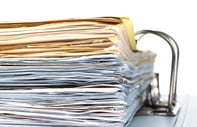Published on
Using an Electronic Portfolio as a Capstone Project: The Rationale, Logistics and Reflections (Part 1)

A persistent challenge that academic programs face is developing and implementing methods of summative assessment that are simultaneously rigorous, meaningful and valuable for the students, especially when the assessment is a capstone project completed just before the awarding of a degree. Additionally, summative assessments should, ideally, inform program administrators about how well their students are picking up the breadth of subject knowledge required as they progress through the program. When carefully designed and administered, portfolio assessment can be a beneficial tool to assess both the individual student’s learning and the effectiveness of an academic program.
The School of Library and Information Science (SLIS) at San Jose State University has been using a self-reflective electronic portfolio, or “e-Portfolio,” as a culminating project option for the Master’s in Library and Information Science (MLIS) degree since 2006. The e-Portfolio is offered as an alternative to the thesis, and the vast majority of students (~98 percent) consistently choose the e-Portfolio. While the thesis provides students the opportunity to delve into a single research question, the e-Portfolio provides students the opportunity to reflect on the breadth of their coursework, including areas that they do not intend to pursue professionally but are, nevertheless, a part of our professional foundations.
In striving to develop something that served our program’s purpose as a capstone academic project and that was both appropriately challenging and beneficial to students, we turned to documents published by our professional organizations, the American Library Association (ALA) and the Special Library Association (SLA), regarding the skills and knowledge incoming library and information professionals should possess. The SLIS faculty distilled these documents into 15 competencies, and then began the process of building our curriculum around these competencies, which are later assessed in the e-Portfolios.
Our program’s unique status as a fully online master’s program — and as the largest ALA-accredited library and information science program in the world — has provided simultaneous challenges and opportunities that we have addressed since 2006 when we introduced the e-Portfolio. Our experience with shepherding hundreds of students — scattered all over the country and even across the globe — through this project each semester has provided ample opportunity for us to encounter and manage technical, curricular and administrative challenges.
Structure and content of the e-Portfolio
The e-Portfolio has five main parts: an introduction, a statement of professional philosophy, 14 competency essays, a conclusion and an affirmation statement.
The introduction is a brief overview and orientation to the whole e-Portfolio, with an explanation of the site’s organization and a summary of the process the student undertook in completing the e-Portfolio.
In the statement of professional philosophy, the student explains his or her professional goals vis-à-vis the courses taken in the MLIS program. Additionally, the student integrates the final competency (Competency O) into the professional philosophy, explaining how he or she intends to “contribute to the cultural, economic, educational, and social well-being” of the community.
For each of the 14 remaining competencies, the student explicates the competency statement systematically and thoroughly in a concise essay. There is an artifacts section where the student links to three artifacts and explains how each one illustrates competence in the area being discussed. These artifacts can take any form — Word documents, videos, web pages, images and others; typically, they are drawn from the student’s coursework, but they may come from work experience, internships or other parts of the student’s life. Finally, there is a short conclusion to each essay in which the student explains how he or she is going to apply this knowledge in settings outside of school.
After the 14 competency essays, the student adds a conclusion to the e-Portfolio. This conclusion includes reflections on the MLIS program, a discussion of the student’s strengths and a professional growth plan.
The last component is the affirmation statement, which asserts the student’s academic integrity and confirms the student has made every effort to protect the privacy of other students and institutions.
By the end, students have produced about 75 pages of polished, original text, in addition to the roughly 45 artifacts of varying lengths and formats that they have put forth as evidence of their competencies.
Check back next week for the second part of this series, where we will explain the technologies employed in the e-Portfolio.



